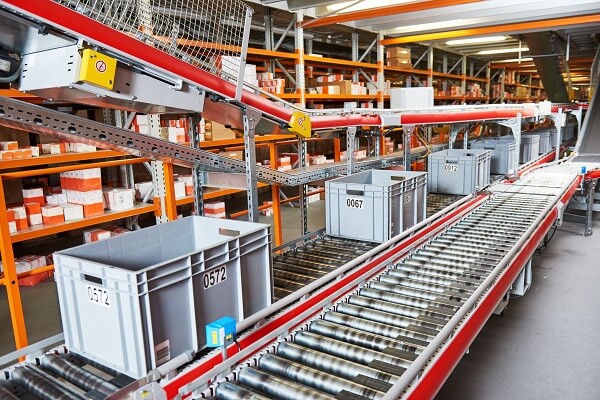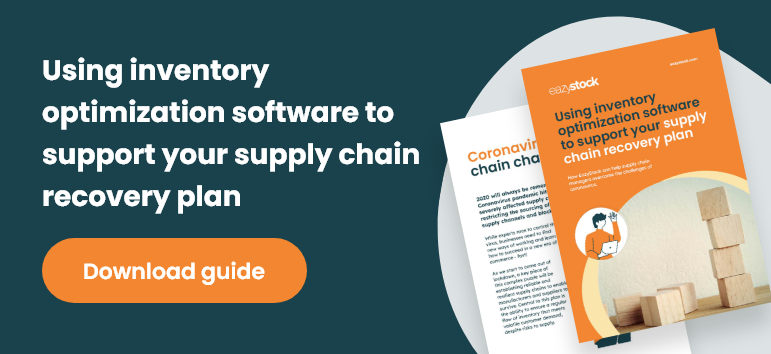COVID-19 Inventory Planning Guide
In this four-part blog series we look at the impact COVID-19 has had on supply chains and how inventory optimization software can help. So far we’ve discussed how to overcome demand forecasting challenges due to Coronavirus. In this post we focus on inventory planning and how to optimize stock levels despite erratic customer behavior and supply restrictions.
Countries across the globe are responding to COVID-19 in different ways, causing the demand and supply of goods to fluctuate up and down. As lockdown measures are eased and reimposed at varying rates, customer demand for many items will continue to rise and fall respectively. At the same time, the supply of raw materials and finished items will remain disrupted.
For inventory management teams to effectively plan and secure their stock requirements during the COVID-19 pandemic and beyond, they need to overcome a number of fundamental challenges:
- How to regularly review demand forecasts and understand demand patterns for each of their inventory items.
- How to identify stock items that are critical to their business. For manufacturers these are items that are critical to prevent production stoppages, whereas suppliers, distributors and retailers need to prevent running out of their best-selling products.
- How to prevent excess stock piling up in the warehouse.
- How to monitor stock levels at each stage of the supply chain and ensure every item is put to best use.
- How to keep stock investment as low as possible without a negative impact on service levels (stock availability) and customer satisfaction.
Finally, with so many businesses facing cashflow issues, it’s important to free up working capital. However, no business wants to do this at the expense of and failing to fulfill customer orders.
Here’s a number of ways you can do that using inventory optimization:
Forecasting demand
In our second post of this series we take an in-depth look at how to forecast demand during the Coronavirus pandemic. With customers’ buying patterns so erratic, producing accurate forecasts is challenging. We therefore also look at ways to overcome this, with a number of ‘safety nets’ that inventory optimization software can provide.
Identifying and managing critical stock during COVID-19
When supply is restricted or lead times are unreliable, it’s important to identify stock items that are critical to your business and build an inventory plan to alleviate the risks. Manufacturers need to analyze their bill of materials (BOM) and highlight components that could cause production delays or stoppages. Suppliers, distributors and retailers should identify products that they need in stock to keep customers happy and revenue flowing into the business. You can then prioritize these items over others; for example, checking demand, stock levels and reviewing lead times more frequently to help ensure availability at all times.
 Doing this manually, however, takes time and resources. However, with an inventory optimization tool like EazyStock, this becomes a straightforward task. You simply load your list of critical items into the system so you can easily monitor them more closely and set individual replenishment parameters.
Doing this manually, however, takes time and resources. However, with an inventory optimization tool like EazyStock, this becomes a straightforward task. You simply load your list of critical items into the system so you can easily monitor them more closely and set individual replenishment parameters.
Investing in the right inventory
With cashflow tight, inventory teams need to invest in stock that’s going to generate revenue, not sit in the warehouse. Having a detailed understanding of your inventory will help this happen.
Many inventory planning teams will use a simple stock classification model, such as ABC inventory analysis, to categorize inventory based on each item’s value to the business. Using the Pareto Principle, 80% of sales will come from 20% of your inventory, so it makes sense to identify items that make up that 20% and set stocking policies to help secure their supply!
However, ABC analysis is quickly out-of-date. It also takes time, and right now your team may be far too busy to do the math.
In comparison, inventory optimization software will analyze every stock item in your business and automatically classify it based on a much wider range of criteria to segment your inventory much more precisely. This criteria includes the cost of goods sold, how often an item is picked, an item’s demand volume and it’s demand volatility. This is a much more advanced, multi-dimensional classification model than ABC analysis that allows you to optimize stock levels to ensure high service levels e.g. stock availability.
With stock categorized into over 200 segments (if required), EazyStock then applies stocking rules that are configured during implementation and manually adjustable based on what’s happening in your market. These rules, or inventory policies, help achieve your target service levels. As a general rule, items with consistent demand and a low cost to sell will have high service levels, while those that are expensive to stock and sell very inconsistently will have lower service levels. However, if these latter items are also critical to your business, you can flag them in a critical items list (as above) and assign appropriate stocking rules.
Every day EazyStock dynamically updates your ‘inventory matrix’, moving items between categories and automatically updating inventory policies, when required.
The result is that your inventory levels are automatically optimized, allowing your business to invest in the right stock items, keep stockouts to a minimum and reduce the risk of excess inventory.
Understanding the impact of inventory investment on order fulfillment
A common challenge for many inventory planning teams is looking for ways to reduce investment tied up in inventory without a reduction in order fulfillment rates or service levels.
EazyStock’s target service level simulation tool helps you understand the relationship between your inventory investment and service levels. It allows you to simulate investment adjustments, so you can see the potential impact on your service levels. And, in reverse, you can understand how increases or decreases in service levels will deliver savings or inflate costs. This helps you use your cash wisely, understand business implications and plan for change.
Redistributing ‘useful’ inventory
Identifying and using surplus stock along your supply chain is one way to help alleviate the pressure on supply and could be the difference between business continuity and grinding to a standstill.
Many companies will have surplus stock. This could be in the form of finished goods reserved for customers who no longer need them, excess stock sat in satellite warehouses, obsolete goods superseded by newer models, spare parts, or items being held by suppliers/stores that are not currently trading. Global distributors may also find that they have excess stock in some countries, due to lockdown, while other locations are booming.
A good warehouse management system (WMS) or perhaps your enterprise resource planning (ERP) platform will tell you how much of every stock item you hold in your warehouse network. EazyStock can take this one step further and identify which of this stock is needed to satisfy upcoming demand and what is excess. You can then move stock around to help prevent stockouts.
EazyStock can also redistribute stock automatically. For example, when confirming an order, it can recommend stock redistribution instead of ordering from a supplier, as this is often a more economical choice.
Smart inventory planning
At a time when cash is a precious commodity for most businesses, optimizing stock levels is an important way to release working capital. But trying to do this manually with spreadsheets or using your WMS or ERP system is challenging at the best of times. Right now, with supply and demand so unpredictable and internal resources pushed to their limits, it’s almost impossible.
Using an inventory optimization tool, such as EazyStock will help you lower your stock levels without compromising stock availability. If you’d like to see a demo to find out how, please contact us today.







